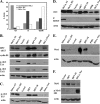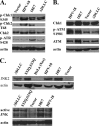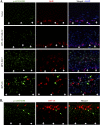Human papillomavirus (HPV) E7 induces prolonged G2 following S phase reentry in differentiated human keratinocytes
- PMID: 21321122
- PMCID: PMC3083224
- DOI: 10.1074/jbc.M110.197574
Human papillomavirus (HPV) E7 induces prolonged G2 following S phase reentry in differentiated human keratinocytes
Abstract
The productive program of human papillomaviruses occurs in differentiated squamous keratinocytes. We have previously shown that HPV-18 DNA amplification initiates in spinous cells in organotypic cultures of primary human keratinocytes during prolonged G(2) phase, as signified by abundant cytoplasmic cyclin B1 (Wang, H. K., Duffy, A. A., Broker, T. R., and Chow, L. T. (2009) Genes Dev. 23, 181-194). In this study, we demonstrated that the E7 protein, which induces S phase reentry in suprabasal cells by destabilizing the p130 pocket protein (Genovese, N. J., Banerjee, N. S., Broker, T. R., and Chow, L. T. (2008) J. Virol. 82, 4862-4873), also elicited extensive G(2) responses. Western blots and indirect immunofluorescence assays were used to probe for host proteins known to control G(2)/M progression. E7 expression induced cytoplasmic accumulation of cyclin B1 and cdc2 in the suprabasal cells. The elevated cdc2 had inactivating phosphorylation on Thr(14) or Tyr(15), and possibly both, due to an increase in the responsible Wee1 and Myt1 kinases. In cells that harbored cytoplasmic cyclin B1 or cdc2, there was also an accumulation of the phosphatase-inactive cdc25C phosphorylated on Ser(216), unable to activate cdc2. Moreover, E7 expression induced elevated expression of phosphorylated ATM (Ser(1981)) and the downstream phosphorylated Chk1, Chk2, and JNKs, kinases known to inactivate cdc25C. Similar results were observed in primary human keratinocyte raft cultures in which the productive program of HPV-18 took place. Collectively, this study has revealed the mechanisms by which E7 induces prolonged G(2) phase in the differentiated cells following S phase induction.
Figures





References
Publication types
MeSH terms
Substances
Grants and funding
LinkOut - more resources
Full Text Sources
Molecular Biology Databases
Research Materials
Miscellaneous

